The kitchen is more than just a place to prepare meals—it’s where families gather, stories unfold, and cultures blend through the universal language of food. Yet too often, this vibrant heart of the home gets trapped in a world of white cabinets and stainless steel, missing the opportunity to truly reflect your personality and heritage.
As someone who specializes in blending rich cultural elements with contemporary design, I’ve seen firsthand how even small decorative changes can transform a kitchen from sterile to stunning. The right kitchen decoring ideas don’t require demolition or designer budgets—just thoughtful touches that speak to who you are and how you live. Ready to infuse your cooking space with color, texture, and meaning? Let’s explore 20 ways to create a kitchen that nourishes both body and spirit.
1. Revamp Your Cabinets with Statement Hardware
Cabinet hardware is like jewelry for your kitchen—small but mighty in its visual impact. Swapping out standard pulls and knobs for pieces with character instantly elevates the entire space without the commitment of a full cabinet renovation. Consider hammered brass for warmth, matte black for drama, or even hand-painted ceramic knobs that reference your cultural heritage.

For Indian-inspired kitchens, look for hardware with intricate patterns reminiscent of traditional jali screens or metalwork with the organic curves found in mehndi designs. The contrast of ornate hardware against simple cabinetry creates a beautiful tension between contemporary and traditional elements—a signature of successful fusion design.
The inspiration for this collection struck when I visited a client’s home where antique brass temple bells had been cleverly repurposed as drawer pulls, creating an unexpected conversation piece that honored family history while functioning beautifully in a modern kitchen.
2. Create a Cultural Backsplash Narrative
The backsplash occupies prime visual real estate in your kitchen, making it the perfect canvas for bold expression. Rather than playing it safe with subway tile, consider this space an opportunity to tell a story through pattern, color, and texture. Hand-painted tiles inspired by global traditions—from Portuguese azulejos to Mexican talavera to Indian block prints—bring instant character and depth.
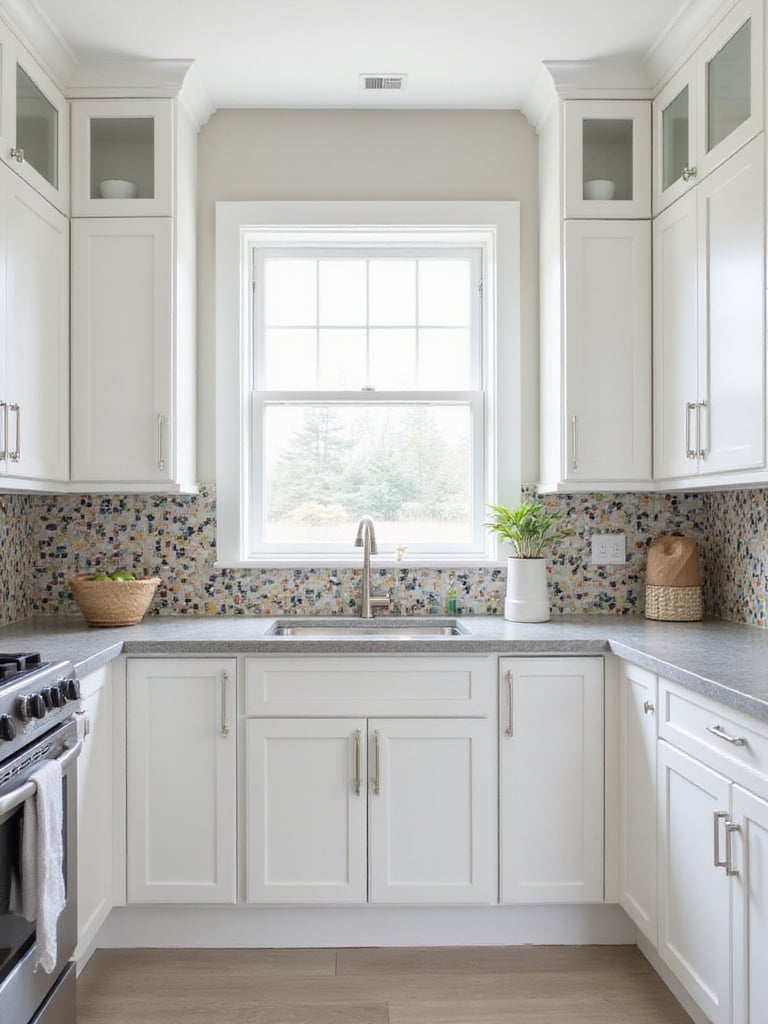
For those hesitant about committing to a permanent installation, removable tile decals offer a renter-friendly alternative that delivers high impact with minimal investment. The key is choosing designs that resonate with your personal heritage or aesthetic preferences while complementing your existing color palette.
The magic of this piece lies in its ability to transform the entire kitchen atmosphere through a relatively small surface area. I’ve watched clients’ faces light up when they see how a vibrant backsplash can make standard white cabinets suddenly feel intentional and deeply personal.
3. Illuminate Your Heritage with Pendant Lighting
Lighting is often overlooked as mere function, but the right pendant fixtures can become sculptural elements that draw the eye and cast your kitchen in a completely new light. Look beyond standard fixtures to options that reference cultural motifs—perforated metal pendants inspired by Moroccan lanterns, colorful glass fixtures reminiscent of Indian bangles, or woven bamboo shades that bring natural texture overhead.
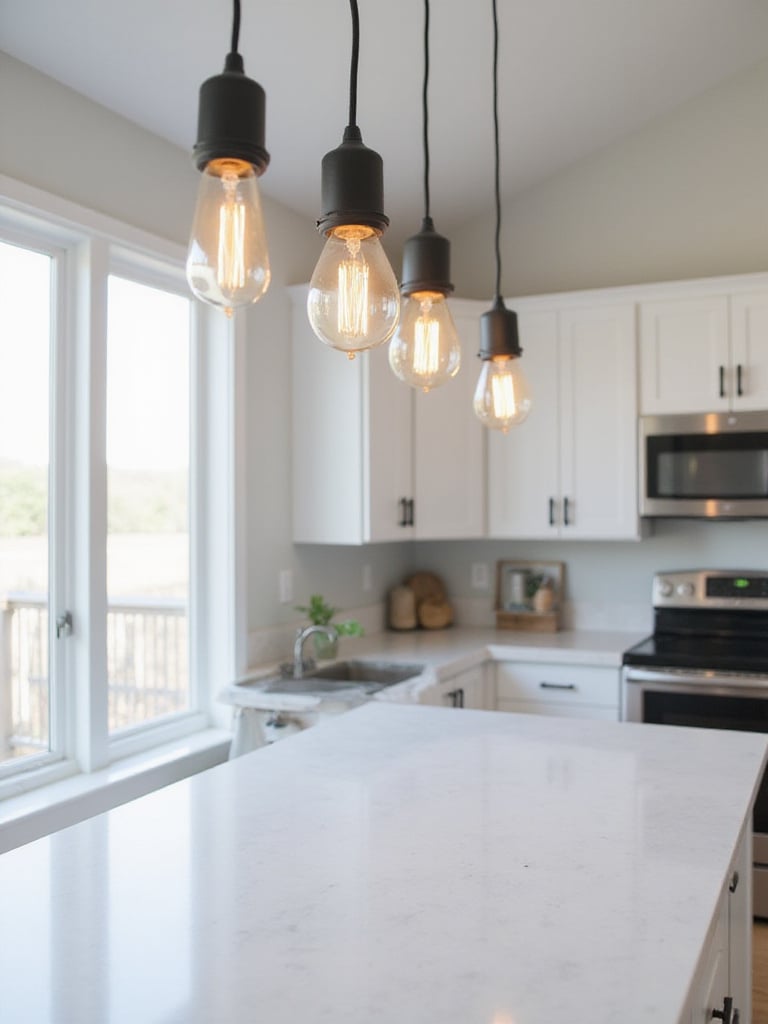
The layering of light sources is just as important as their style. Combine statement pendants over islands or dining areas with under-cabinet lighting for tasks and ambient lighting for overall illumination. This creates a kitchen that can transition from bright and energetic during meal prep to warm and intimate for evening gatherings.
Unlike mass-produced alternatives, this technique allows your lighting to become a meaningful focal point rather than an afterthought. When selecting pendants, consider how they’ll look both lit and unlit, as they’ll be visible elements in your kitchen throughout the day.
4. Embrace the Power of a Color Story Wall
An accent wall provides the perfect opportunity to introduce bold color without overwhelming your space. In kitchens where cabinets dominate most wall surfaces, even a small section of vibrant color can make a dramatic difference. Consider rich jewel tones like sapphire blue, emerald green, or ruby red—colors that feature prominently in many cultural design traditions and create a sense of abundance and warmth.
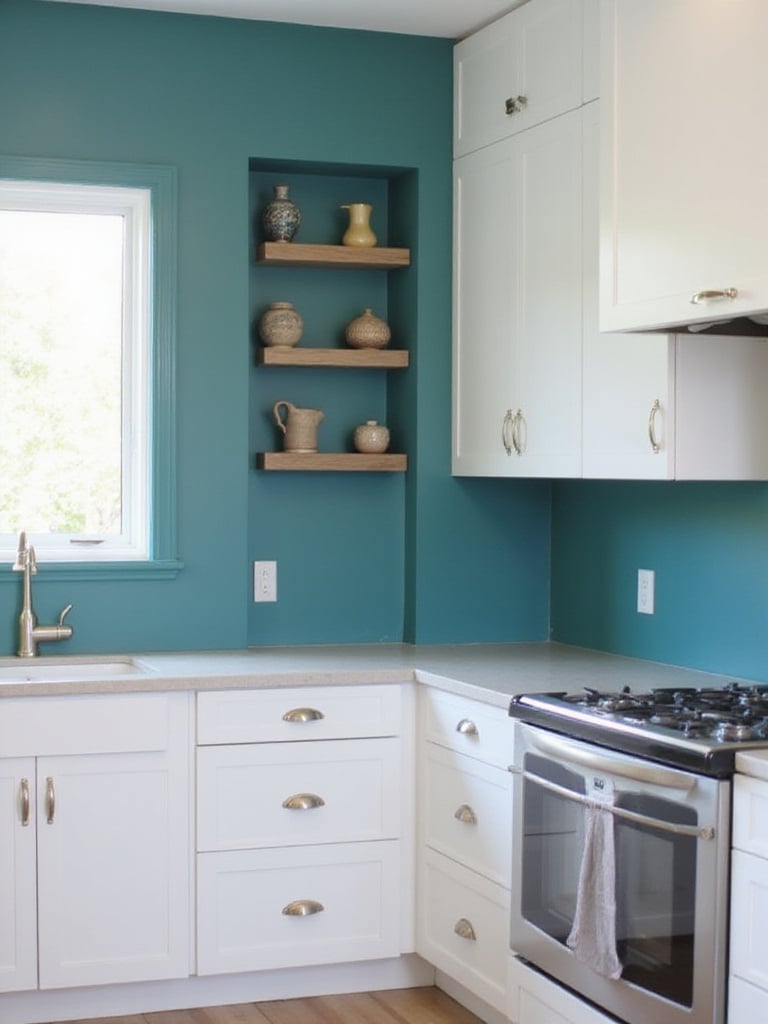
For those wanting to reference Indian design specifically, consider the saturated hues of Rajasthan—vibrant pinks, yellows, and oranges that feel simultaneously traditional and contemporary. These colors pair beautifully with natural wood tones and metallic accents, creating a balanced space that feels both grounded and joyful.
The unexpected environmental benefit comes from how color can transform your kitchen’s mood without requiring new materials or construction. A thoughtfully chosen paint color is perhaps the most sustainable kitchen decoring idea, creating maximum impact with minimal resources.
5. Open Shelving as Cultural Display
Open shelving does double duty in the kitchen—offering convenient storage while creating opportunities to display treasured items that might otherwise remain hidden in cabinets. This approach invites you to curate a visual story through everyday objects, from family heirloom dishes to handcrafted pottery collected during travels.
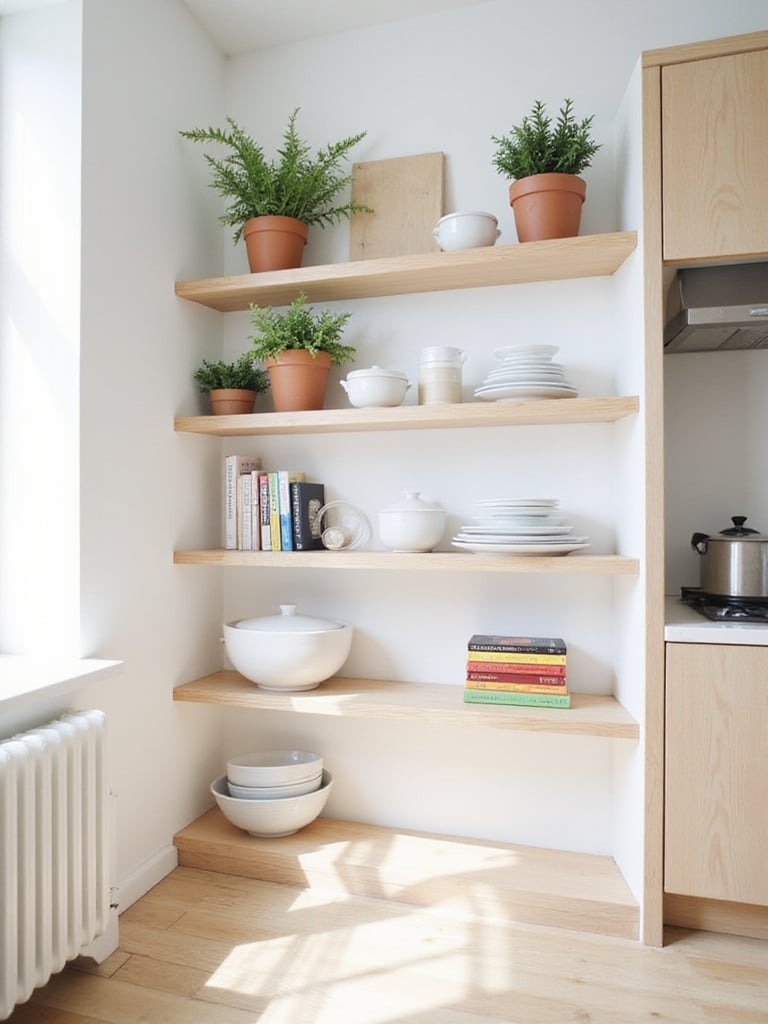
The key to successful open shelving lies in thoughtful editing. Rather than displaying everything, select pieces that share a color story or thematic connection. Group items in odd numbers, vary heights and textures, and leave some negative space to allow the eye to rest. Consider incorporating small artwork, plants, or spice vessels to add dimension and personality.
What surprises clients most is how this works with even the most humble kitchen items. When arranged with intention, everyday glasses, plates, and bowls become part of your kitchen’s decorative language, especially when they reflect cultural patterns or colors that resonate with your heritage.
6. Cultivate a Living Spice Garden
Plants bring literal life to kitchen decoring ideas, but they can do more than just sit pretty. A thoughtfully arranged herb garden connects your kitchen to ancient culinary traditions while providing fresh ingredients for your cooking. Consider displaying potted curry leaves, holy basil (tulsi), mint, and coriander—staples in Indian cooking that thrive indoors with proper light.
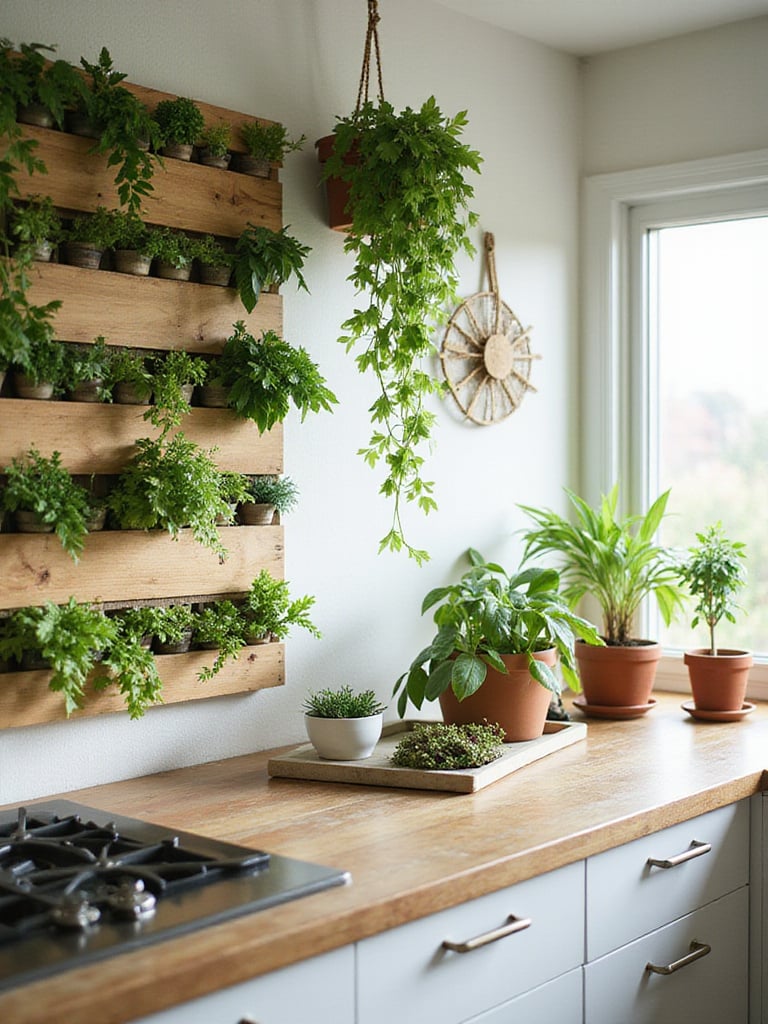
Beyond herbs, incorporate plants with cultural significance. A small potted jasmine plant offers delicate fragrance and beautiful blooms, while a money plant (pothos) is considered auspicious in many Asian traditions while being nearly impossible to kill—perfect for busy cooks with variable green thumbs.
The cultural heritage preserved in each piece includes connections to ancestral wisdom about plants as both food and medicine. These living elements remind us that kitchens have always been spaces of nourishment and healing across cultures and generations.
7. Curate Meaningful Accessories with Purpose
The most successful kitchen decoring ideas incorporate objects that tell a story while serving a purpose. Look for opportunities to replace generic kitchen tools with handcrafted alternatives that bring beauty to everyday tasks—a hand-carved wooden spoon rest, brass measuring cups that double as display pieces, or a marble mortar and pestle that’s both functional and sculptural.

When selecting accessories, consider how they reflect your heritage or aesthetic preferences. A collection of copper vessels traditionally used in Indian cooking makes a stunning display on open shelving while remaining accessible for use. Handwoven textiles can become table runners or napkins that add color and texture to dining areas.
The designer’s secret here is to choose items that work as hard as they look beautiful. The most successful kitchen accessories earn their place through both function and form, creating a space that feels curated rather than cluttered.
8. Make a Statement with a Sculptural Faucet
The kitchen faucet is touched countless times daily, making it both a functional necessity and an opportunity for tactile pleasure. Upgrading to a statement faucet in an unexpected finish—unlacquered brass that will patina beautifully, hammered copper with living finish, or even matte black for dramatic contrast—can transform your sink area into a focal point.

Look for designs that reference architectural elements from your cultural heritage. Curves and proportions inspired by traditional water vessels or temple architecture can bring subtle cultural resonance to even the most contemporary kitchen. Consider the handle style as well—lever handles offer accessible function while knob styles can reference traditional forms.
The craftsmanship reveals itself in details like the weight of the handle in your hand and the smooth operation of the valve. A quality faucet becomes more beautiful with use, developing a patina that tells the story of your family’s daily rituals around water and cleansing.
9. Ground Your Space with Textiles Underfoot
Kitchen rugs and mats offer comfort underfoot while introducing pattern, color, and texture to ground your kitchen decoring ideas. Look beyond standard kitchen mats to textiles with cultural significance—flat-woven dhurries in geometric patterns, vibrant kilims with rich history, or even indoor/outdoor rugs inspired by rangoli patterns that can withstand kitchen spills.

When selecting kitchen textiles, balance beauty with practicality. Choose materials that can be easily cleaned, such as indoor/outdoor polypropylene that mimics the look of natural fibers, or cotton rugs with low pile that can be machine washed. Position rugs strategically in areas where you stand most often—in front of the sink, stove, or prep areas.
The interplay between the colors creates a foundation that ties together other elements in your kitchen color scheme. A well-chosen rug can be the starting point for your entire kitchen color palette, informing choices for accessories, artwork, and even small appliances.
10. Frame Kitchen Windows with Cultural Textiles
Window treatments offer another opportunity to introduce textile art into your kitchen. Rather than standard blinds, consider cafe curtains made from vintage saris, block-printed cotton, or hand-embroidered fabrics that filter light beautifully while adding pattern and color. These textiles become living art that shifts throughout the day as light moves through the space.

For a more structured look, Roman shades in fabrics with cultural motifs provide clean lines while still offering decorative impact. Look for patterns that reference traditional textiles from your heritage—ikat weaves, suzani embroidery, or batik prints all translate beautifully to kitchen window treatments.
The revival of this classic form comes with a twist when you incorporate textiles with cultural significance. Even in the most contemporary kitchen, these fabric elements add softness, acoustic benefits, and a connection to textile traditions that have adorned homes for centuries.
11. Elevate Your Space with Cultural Seating Elements
Kitchen seating provides an opportunity to introduce sculptural forms and tactile materials that reference cultural design traditions. Instead of standard bar stools, consider options with handwoven seats inspired by traditional weaving techniques, carved wooden details that echo architectural elements, or metal frames with shapes derived from historic furniture forms.

Color plays a crucial role in seating choices. Bold-hued cushions or fully upholstered seats in vibrant fabrics can become the perfect counterpoint to neutral cabinetry. For a more subtle approach, natural materials with rich texture—rattan, cane, rope, or leather—add warmth and tactile interest while maintaining a neutral palette.
The silhouette draws inspiration from traditional seating forms across cultures, reinterpreted for contemporary kitchens. I often recommend clients look to the low stools used in traditional Indian homes or the intricate woodwork of ancestral furniture for inspiration that can be translated into modern seating that honors heritage.
12. Illuminate Work Surfaces with Intentional Lighting
Under-cabinet lighting is practical magic in the kitchen, transforming how you experience color and texture while making meal preparation safer and more enjoyable. Beyond basic strip lights, consider options that enhance your cultural kitchen decoring ideas—copper-toned LEDs that cast a warm glow reminiscent of traditional oil lamps, or color-changing systems that can shift from practical white light to atmospheric colored illumination for gatherings.

The placement of under-cabinet lighting should be strategic, highlighting both work surfaces and decorative elements like backsplashes or displayed collections. Consider how the light interacts with different materials—how it brings out the depth in wooden cutting boards, makes spice colors more vibrant, or highlights the texture of stone countertops.
While designed for the living room, we’ve seen creative uses in kitchens where lighting traditionally reserved for art highlighting is repurposed to illuminate collections of copper vessels or ceramic plates displayed on open shelving, creating museum-quality vignettes within your everyday space.
13. Organize Spices in Artisanal Containers
Spices are the literal flavor of cultural cooking traditions, making them perfect candidates for both organization and display. Replace generic store packaging with a coordinated system of containers that celebrates these precious ingredients—small brass vessels, hand-painted ceramic jars, or clear glass containers with custom labels in decorative scripts.

Consider creating a dedicated spice display that elevates these everyday ingredients to art status. A wall-mounted spice rack with matching containers creates visual rhythm, while a collection of varied vessels grouped on a tray or lazy Susan combines functionality with visual interest. Label your spices in both English and their original language names as a subtle educational element.
The artisan collective that creates these pieces often continues generations-old metalworking or ceramic traditions, meaning your spice organization system becomes a way to support cultural craftsmanship while enhancing your daily cooking experience with kitchen decoring ideas that serve multiple purposes.
14. Curate a Cultural Art Gallery
Kitchen walls offer prime real estate for personal expression through art. Rather than generic “kitchen” prints, consider creating a gallery that references your cultural heritage—framed textiles like embroidered handkerchiefs or fabric samples, vintage food advertisements from your family’s country of origin, or contemporary art that reinterprets traditional motifs.

The kitchen gallery wall becomes most meaningful when it includes personal elements—perhaps a framed handwritten family recipe, photographs of relatives cooking together, or children’s interpretations of cultural food traditions. These personal touches transform generic kitchen decoring ideas into a space that tells your specific story.
The unexpected pairing that always works is combining different media in your kitchen gallery—a painted plate mounted alongside framed art, a small woven textile next to a contemporary print, or vintage utensils arranged as sculptural elements. This creates visual interest while allowing you to incorporate items of varying significance.
15. Create a Ritually-Inspired Beverage Station
Beverage rituals exist across cultures—from elaborate tea ceremonies to coffee traditions to the mixing of refreshing summer drinks. Create a dedicated station that elevates these daily rituals, incorporating elements that reference their cultural origins. For a chai station, include a traditional kettle, small brass or ceramic cups, and containers for fresh spices.

The organization of your beverage station should balance beauty with functionality. Store frequently used items at easy reach, while displaying special pieces like a handcrafted tea pot or collection of ceremonial cups as decorative elements. Include artwork or a small framed quote about the beverage tradition to add meaning to the space.
Imagine coming home to the gentle glow of copper vessels catching the light as you prepare your evening tea, the ritual itself becoming a moment of connection to heritage and a pause in your busy day. These intentional spaces for ritual transform functional kitchen decoring ideas into opportunities for mindfulness.
16. Display Artisanal Cutting Boards as Wall Art
Cutting boards crafted from beautiful woods or materials specific to certain cooking traditions make stunning wall displays when not in use. Look for boards with unique grain patterns, interesting shapes, or cultural significance—perhaps a board made from the wood traditionally used for cooking implements in your ancestral cuisine.

Arrange cutting boards in an intentional composition that considers balance and visual interest. Mix sizes, shapes, and wood tones while maintaining enough cohesion for the grouping to feel intentional. Consider adding one statement piece with special significance—perhaps an antique board passed down through generations or one brought back from travels.
Beyond the obvious placement, consider using this for creating a focal point that adds warmth and texture to kitchen walls while keeping these functional items easily accessible. The natural variations in wood grain bring organic patterns to often boxy kitchen spaces, softening the overall feel.
17. Incorporate a Cultural Communication Center
Communication centers in kitchens typically focus on function over form, but they can be reimagined through a cultural lens. Replace standard message boards with more meaningful alternatives—a framed section of wall painted with chalkboard paint in a shape inspired by architectural motifs, a magnetic board covered in fabric with cultural patterns, or a traditional slate writing board in a carved frame.

Use this space not just for grocery lists but for sharing cultural wisdom—perhaps a rotating proverb from your heritage, the word of the day in your ancestral language, or a reminder of upcoming cultural celebrations. This transforms a purely practical element into one that strengthens cultural connections daily.
When clients ask us about balancing style with comfort, I often point to these communication centers as perfect examples of how function and meaning can coexist beautifully. These kitchen decoring ideas serve practical needs while reinforcing cultural identity through both form and content.
18. Reimagine Your Ceiling with Statement Lighting
Look up—the ceiling represents significant untapped potential in most kitchens. Beyond basic recessed lighting, consider a statement fixture that references cultural design traditions—a brass pendant with cutwork patterns that cast intricate shadows, a cluster of colorful glass shades inspired by festival lanterns, or a contemporary interpretation of traditional oil lamps.

Scale matters tremendously with ceiling fixtures. In smaller kitchens, a single statement piece with cultural references can create impact without overwhelming the space. In larger kitchens, consider a series of pendants arranged in a pattern that itself references cultural motifs—perhaps following the geometric principles found in traditional architectural layouts.
The ambiance evolves throughout the day as natural light interacts with your fixture, creating different moods from morning to evening. These lighting choices become particularly important in kitchens that serve as gathering spaces for family celebrations and cultural traditions.
19. Introduce Cultural Color Through Small Appliances
Small appliances offer perfect opportunities to introduce vibrant color inspired by cultural palettes. Rather than standard stainless steel or white, look for stand mixers, toasters, kettles, and blenders in hues that reference traditional textiles or ceramics from your heritage—the deep reds and oranges of Indian wedding attire, the cobalt blues of Mediterranean pottery, or the sunny yellows of Mexican talavera.

Strategic placement transforms these functional items into decorative elements. Position colorful appliances against neutral backgrounds where they’ll stand out as intentional color statements. Group complementary colors together for greater impact, or use a single vibrant appliance as a focal point among more neutral pieces.
- Rich vermilion red: References the sacred sindoor powder used in Hindu traditions
- Turmeric yellow: Celebrates the golden spice central to Indian cooking and ceremonies
- Peacock blue: Honors the national bird of India with its auspicious associations
- Marigold orange: Connects to the flowers used in many Indian celebrations
The finishing touch that elevates the entire look comes from choosing appliance colors that directly reference cultural color symbolism, transforming everyday kitchen tools into meaningful connections to heritage and tradition.
20. Integrate Handwoven Baskets for Practical Storage
Storage baskets offer the perfect blend of function and cultural reference. Look for handwoven options that showcase traditional techniques from your heritage—perhaps kauna grass baskets from Northeast India, bamboo weaving with distinctive patterns, or palm leaf baskets with colored accents typical of specific regions.

Arrange baskets strategically throughout your kitchen—hanging from hooks, stacked on open shelving, or tucked into cabinets with their edges visible. Use them to store everything from produce to bread to linens, allowing their natural textures to add warmth to the space while keeping essentials organized.
The artisans behind these designs began with techniques passed down through generations, often using sustainable materials native to specific regions. By incorporating these baskets into your kitchen decoring ideas, you support traditional craftsmanship while adding authentic cultural elements to your daily environment.
Conclusion
The most beautiful kitchens tell a story—your story. Through these 20 kitchen decoring ideas, you can create a space that honors cultural heritage while meeting the practical demands of contemporary life. By thoughtfully incorporating elements with meaning—from the hardware on your cabinets to the baskets that store your produce—you transform a utilitarian space into one that nourishes both body and soul.
Remember that successful fusion design isn’t about recreating a traditional kitchen from another time or place. Instead, it’s about thoughtful integration of elements that resonate with your personal history and aesthetic preferences. Start with one or two kitchen decoring ideas that speak to you most strongly, then build gradually, allowing your space to evolve organically into a kitchen that truly feels like home—vibrant with color, rich with meaning, and uniquely yours.






